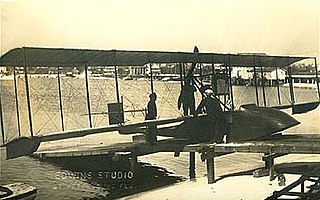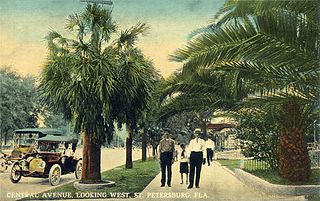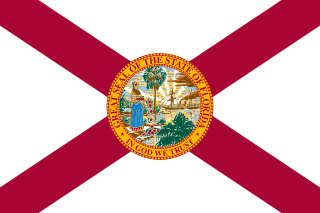
An airline is a company that provides air transport services for traveling passengers or freight. Airlines use aircraft to supply these services and may form partnerships or alliances with other airlines for codeshare agreements, in which they both offer and operate the same flight. Generally, airline companies are recognized with an air operating certificate or license issued by a governmental aviation body. Airlines may be scheduled or charter operators.

Tampa International Airport is an international airport six miles (9.7 km) west of Downtown Tampa, in Hillsborough County, Florida, United States. The airport is publicly owned by Hillsborough County Aviation Authority (HCAA). The airport serves 100 non-stop destinations throughout North America, Central America, the Caribbean and Europe across multiple carriers.

St. Pete–Clearwater International Airport is a public/military airport in Pinellas County, Florida, United States, serving the Tampa Bay Area. It is right on the northeast municipal boundary of Pinellas Park, 9 miles (14 km) north of downtown St. Petersburg, 7 miles (11 km) southeast of Clearwater, and 17 miles (27 km) southwest of Tampa.

A seaplane is a powered fixed-wing aircraft capable of taking off and landing (alighting) on water. Seaplanes are usually divided into two categories based on their technological characteristics: floatplanes and flying boats; the latter are generally far larger and can carry far more. Seaplanes that can also take off and land on airfields are in a subclass called amphibious aircraft, or amphibians. Seaplanes were sometimes called hydroplanes, but currently this term applies instead to motor-powered watercraft that use the technique of hydrodynamic lift to skim the surface of water when running at speed.

This is a list of aviation-related events from 1912:
Pilot licensing or certification refers to permits for operating aircraft. Flight crew licences are issued by the civil aviation authority of each country, which must establish that the holder has met minimum knowledge and experience before issuing licences. The licence, along with the required class or type rating, allows a pilot to fly aircraft registered in the licence issuing state.

Hugh Armstrong Robinson was a pioneer in the earliest days of aviation, combining his skills of inventor, pilot, and daredevil. Among other things, he is said to have been the third person to successfully fly an aircraft after the Wright Brothers in an aircraft of his own design and construction, and the first person to make an air-sea rescue. His many firsts also include the first medical flight transporting a doctor to patient in Hammond, N.Y. in June 1912, and the first U.S. airmail flight in 1911. Robinson also devised the term and art of dive-bombing.

Albert Whitted Airport is a public airport in St. Petersburg, Pinellas County, Florida, United States. It is on the west edge of Tampa Bay, just southeast of downtown St. Petersburg and east of the University of South Florida St. Petersburg.

The Tony Jannus Award recognizes outstanding individual achievement in scheduled commercial aviation by airline executives, inventors and manufacturers, and government leaders. The award is conferred annually by the Tony Jannus Distinguished Aviation Society and was first bestowed in 1964 in Tampa, Florida, U.S. Its namesake, aviation pioneer Tony Jannus, piloted the inaugural flight of the St. Petersburg–Tampa Airboat Line on January 1, 1914, the first scheduled commercial airline flight in the world using heavier-than-air aircraft. In addition to preserving the legacy of Tony Jannus, the non-profit society also offers financial assistance to college students pursuing studies in aviation and conducts an annual essay contest for high school students to encourage careers in aviation.

The Benoist XIV, also called The Lark of Duluth, was a small biplane flying boat built in the United States in 1913 in the hope of using it to carry paying passengers. The two examples built were used to provide the first heavier-than-air airline service anywhere in the world, and the first airline service of any kind at all in the United States.
The Benoist Aircraft Company was an early manufacturer of aircraft in the United States. It was formed in 1912 in St Louis, Missouri, by Thomas W. Benoist. Over the next five years, it would build 106 aircraft, including Benoist XIVs that would be used for the first heavier-than-air airline service. The company dissolved with Tom Benoist's accidental death in 1917.

The St. Petersburg–Tampa Airboat Line was the first scheduled airline using a fixed wing aircraft. The airline provided service between St. Petersburg, Florida and neighboring Tampa across Tampa Bay, a distance of about 23 miles. It was in service from January to May 1914.

Logan Archbold "Jack" Vilas was an aviation pioneer and a member of the Early Birds of Aviation. He was inducted into the Wisconsin Aviation Hall of Fame in 2000.
On the Wing is a 1986 IMAX film featuring a half-sized robotic Quetzalcoatlus that demonstrates principles of animal flight. Produced by the National Air and Space Museum, it also traces the early history of human flight.

Thomas W. Benoist was an American aviator and aircraft manufacturer. In an aviation career of only ten years, he formed the world's first aircraft parts distribution company, established one of the leading early American aircraft manufacturing companies and a successful flying school, and from January to April 1914 operated the world's first scheduled airline.

Lt. James Albert Whitted, was an American aviator from St. Petersburg, Florida. During his career, Whitted was an engineer, an instructor at the Naval flight school and ran a commercial air service business. Whitted was killed in a plane crash near Pensacola, Florida in 1923. The Albert Whitted Airport in St. Petersburg was named after him in 1928.

This region of Pinellas was first settled in the 1830s and 1840s by Odet Phillippe, a French Huguenot from Charleston, SC, along with the McMullen Family from Quitman, Georgia and the British Richard Booth family who planted citrus groves and raised cattle. Following the Civil War, during the Reconstruction era, the city was founded by John C. Williams, formerly of Detroit, who purchased the land in 1876, and by Peter Demens, who was instrumental in bringing the terminus of the Orange Belt Railway there in 1888. St. Petersburg was incorporated on February 29, 1892, when it had a population of only some 300 people.

The first aeronautical event in Florida was presented on January 28, 1878, when a balloon flew over Jacksonville. Florida has since hosted four major aviation events.

David Hugh McCulloch was an early American aviator who worked with Glenn Curtiss from 1912. Curtiss was a contemporary and competitor to the Wright brothers, Wilbur and Orville, who had made the first flights at Kitty Hawk in 1903. Curtiss won the world's first air race at Reims in France in August 1909, and was now becoming the driving force in American aviation. McCulloch's early work with Curtiss consisted of demonstrating, training and selling Curtiss planes and participating in early developments of flight. He trained the First Yale Unit, and in two consecutive days in 1917, he and several of his pupils from the First Yale Unit made flights that convinced the Navy to bring aircraft aboard ships. Later, McCulloch was co-pilot with Holden C. Richardson and flight commander John Henry Towers of the NC-3, the leader of the three Navy flying boats making the first flight across the Atlantic Ocean.




















